Items
Tag is exactly
PPE
-
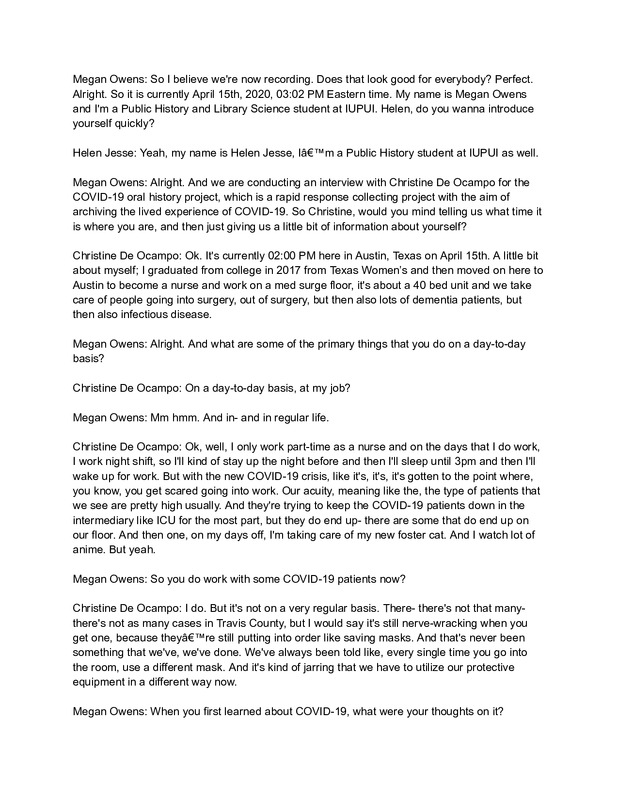 04/15/2020
04/15/2020Christine De Ocampo Oral History, 2020/04/15
-
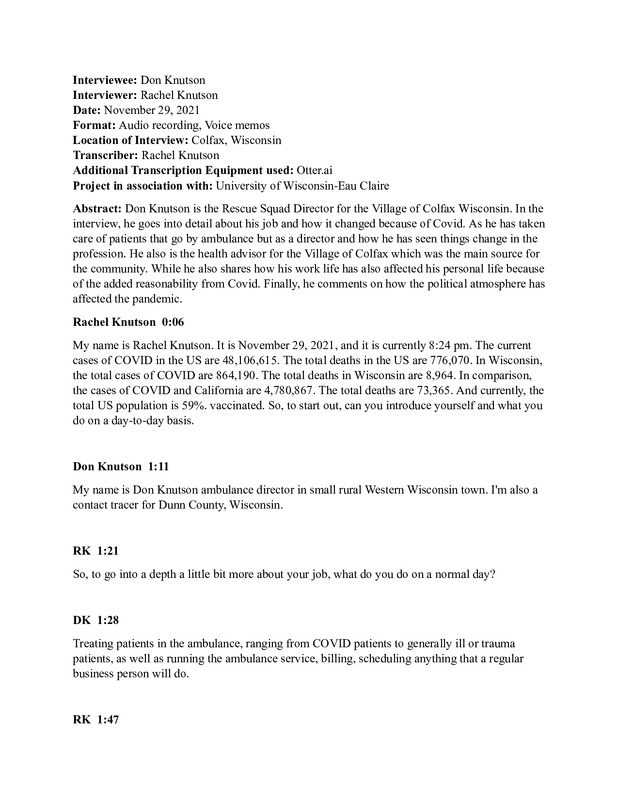 11/29/2021
11/29/2021Don Knutson Oral HIstory, 11/29/2021
Don Knutson is the Rescue Squad Director for the Village of Colfax Wisconsin. In the interview, he goes into detail about his job and how it changed because of Covid. As he has taken care of patients that go by ambulance but as a director and how he has seen things change in the profession. He also is the health advisor for the Village of Colfax which was the main source for the community. While he also shares how his work life has also affected his personal life because of the added reasonability from Covid. Finally, he comments on how the political atmosphere has affected the pandemic. -
 11/27/2021
11/27/2021Rebecca Ferber Oral HIstory, 2021/11/27
Rebecca Lynn Ferber is a resident of Oronoco, MN, and currently works for the Mayo Clinic in Rochester as a CRNA (Certified Registered Nurse Anesthetist). In this interview, Rebecca talks about how COVID has affected her job as a CRNA and Mayo Clinic as a whole as well as a mom and wife. She also talks about how it has affected her family and friends and how some of her relationships have been strained because of different views on COVID. She touches on how it not only affects people's physical health but mental health as well and gives some advice for future generations. -
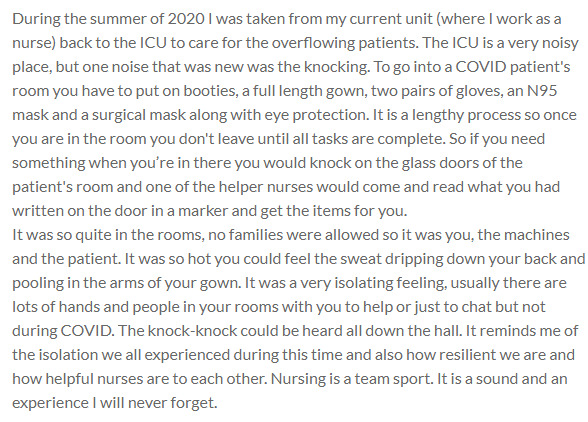 2020-08-06
2020-08-06Knock Knock
During the summer of 2020 I was taken from my current unit (where I work as a nurse) back to the ICU to care for the overflowing patients. The ICU is a very noisy place, but one noise that was new was the knocking. To go into a COVID patient's room you have to put on booties, a full length gown, two pairs of gloves, an N95 mask and a surgical mask along with eye protection. It is a lengthy process so once you are in the room you don't leave until all tasks are complete. So if you need something when you’re in there you would knock on the glass doors of the patient's room and one of the helper nurses would come and read what you had written on the door in a marker and get the items for you. It was so quite in the rooms, no families were allowed so it was you, the machines and the patient. It was so hot you could feel the sweat dripping down your back and pooling in the arms of your gown. It was a very isolating feeling, usually there are lots of hands and people in your rooms with you to help or just to chat but not during COVID. The knock-knock could be heard all down the hall. It reminds me of the isolation we all experienced during this time and also how resilient we are and how helpful nurses are to each other. Nursing is a team sport. It is a sound and an experience I will never forget. -
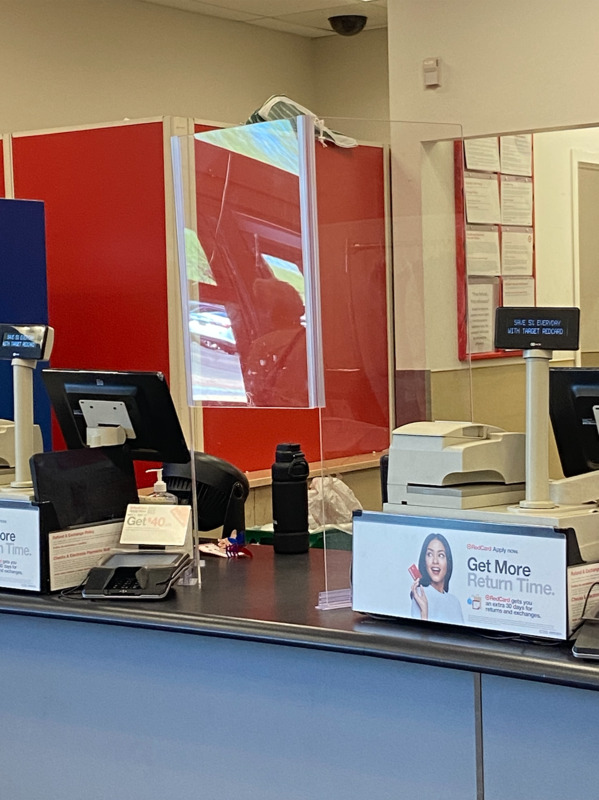 2022-05-23
2022-05-23Sneeze Guard in Target at Tempe Marketplace
This is a sneeze guard seen at Target. This is a COVID-era restriction meant to prevent the spread of COVID. Even though most restrictions are gone, these are still up. -
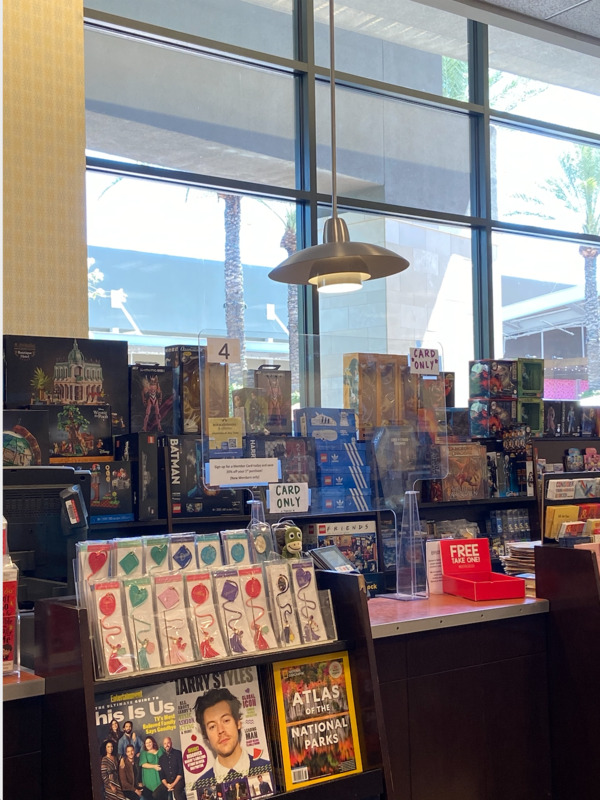 2022-05-23
2022-05-23Sneeze Guard in Barnes & Noble at Tempe Marketplace
This is a picture of a COVID-era restriction put in place at some stores. The store this was seen in was Barnes & Noble. Not pictured, but employees were also wearing masks in addition to the sneeze guards. -
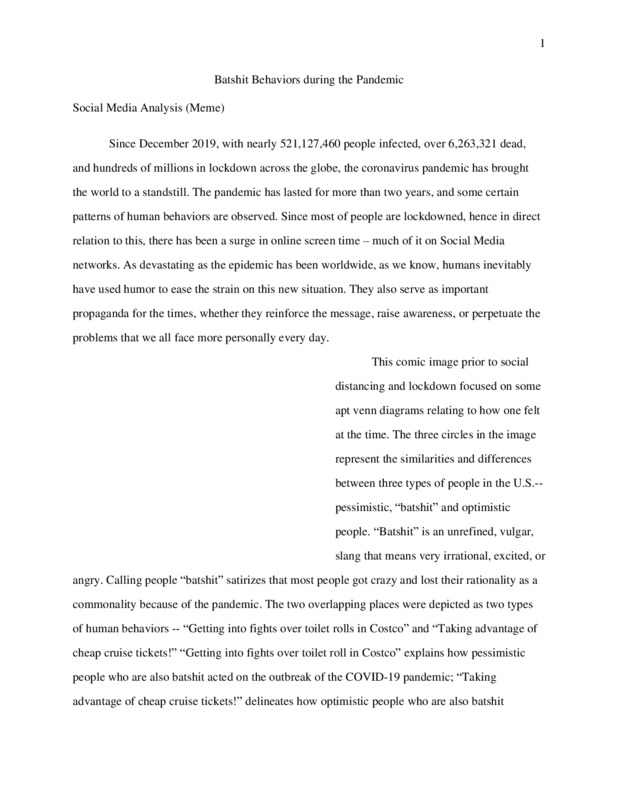 2022-05-16
2022-05-16Batshit Behaviors during the Pandemic
In class, we analyzed the meme related to COVID-19 and hope this will contribute to something. -
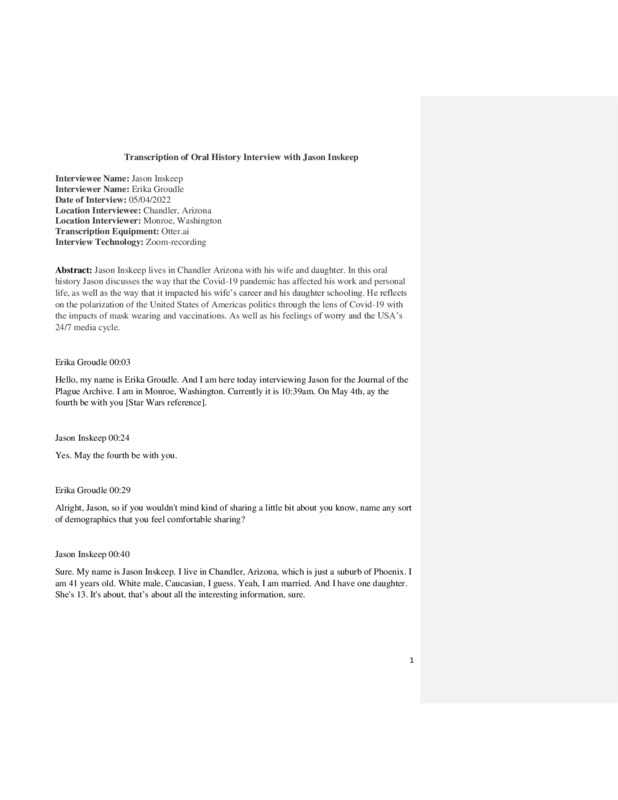 2022-05-04
2022-05-04Jason Inskeep Oral History, 2022/05/04
Jason Inskeep lives in Chandler, Arizona with his wife and daughter. In this oral history Jason discusses the way that the Covid-19 pandemic has affected his work and personal life, as well as the way that it impacted his wife’s career and his daughter schooling. He reflects on the polarization of the United States of Americas politics through the lens of Covid-19 with the impacts of mask wearing and vaccinations. As well as his feelings of worry and the USA’s 24/7 media cycle. -
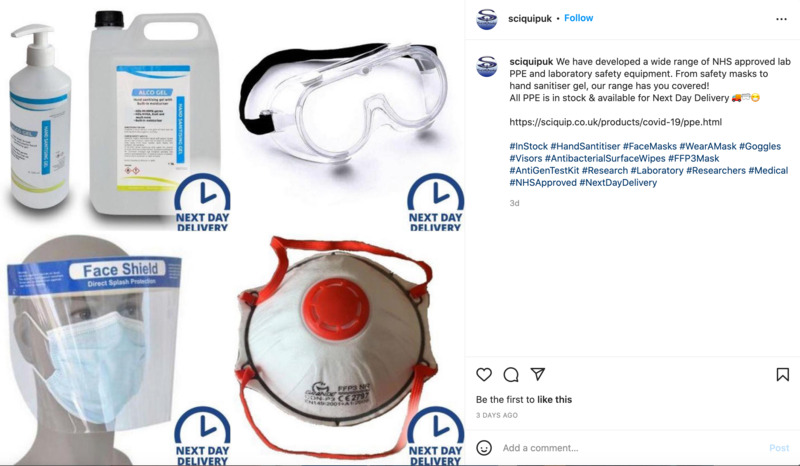 2022-04-08
2022-04-08NHS Approved PPE
This is an Instagram post by sciquipuk. This is a store that sells NHS approved PPE for people to buy. Throughout the pandemic, I have seen people use a variety of these items. I have mostly seen masks. Every once in a while, I have seen people use face shields. This is a good post that demonstrates some of the things people have regularly worn during the course of the pandemic. -
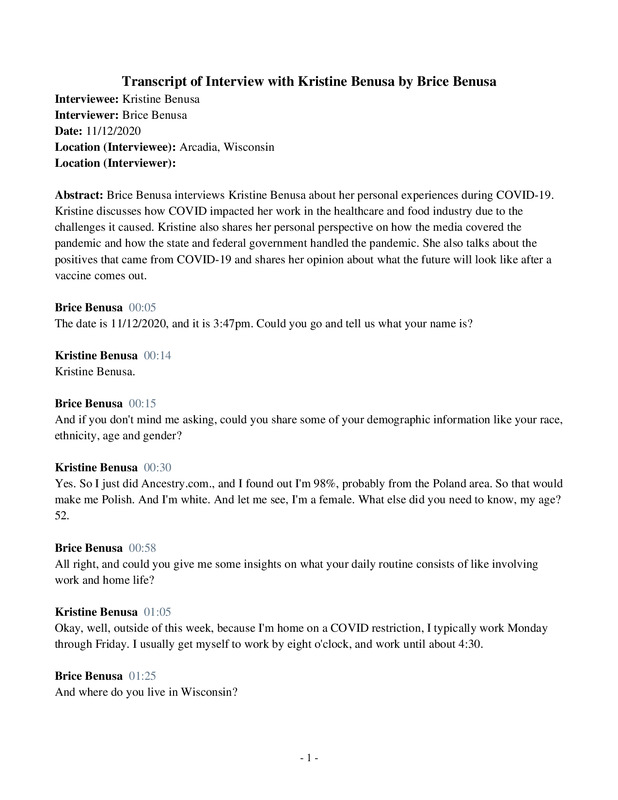 11/12/2020
11/12/2020Kristine Benusa Oral History, 2020/11/12
-
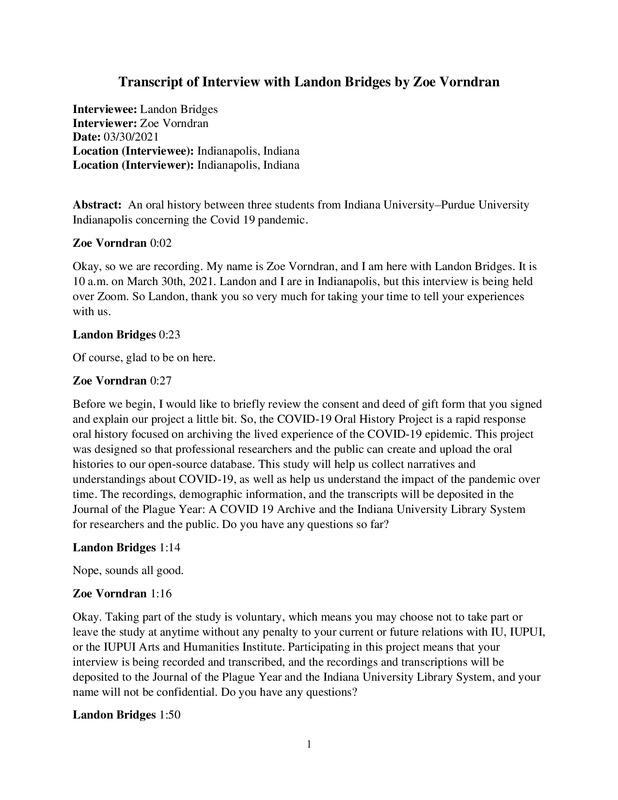 03/30/2021
03/30/2021Landon Bridges Oral History, 2021/03/30
An oral history between three students from Indiana University–Purdue University Indianapolis concerning the Covid 19 pandemic -
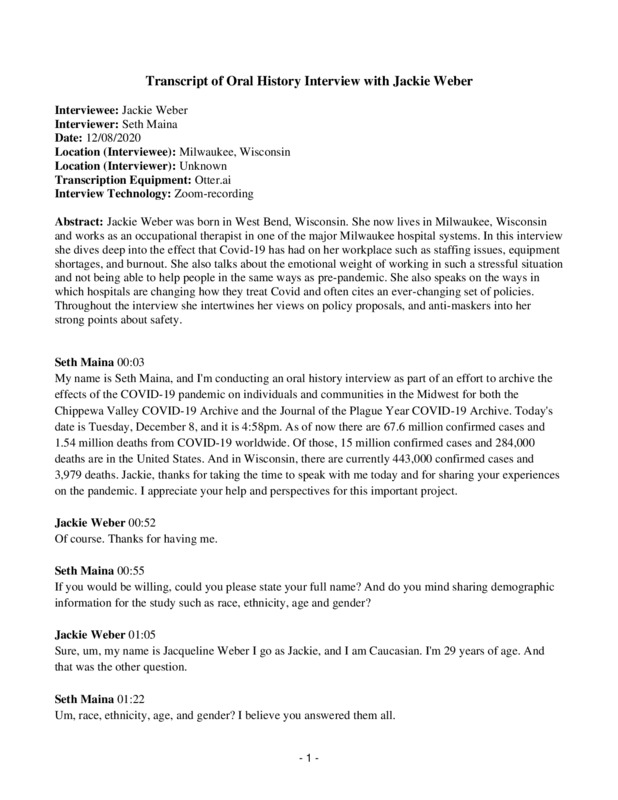 12/08/2020
12/08/2020Jackie Weber Oral History, 2020/12/08
Jackie Weber was born in West Bend, Wisconsin. She now lives in Milwaukee, Wisconsin and works as an occupational therapist in one of the major Milwaukee hospital systems. In this interview she dives deep into the affect that Covid-19 has had on her workplace such as staffing issues, equipment shortages, and burnout. She also talks about the emotional weight of working in such a stressful situation and not being able to help people in the same ways as pre-pandemic. She also speaks on the ways in which hospitals are changing how they treat Covid and often cites an ever-changing set of policies. Throughout the interview she intertwines her views on policy proposals, and anti-maskers into her strong points about safety. -
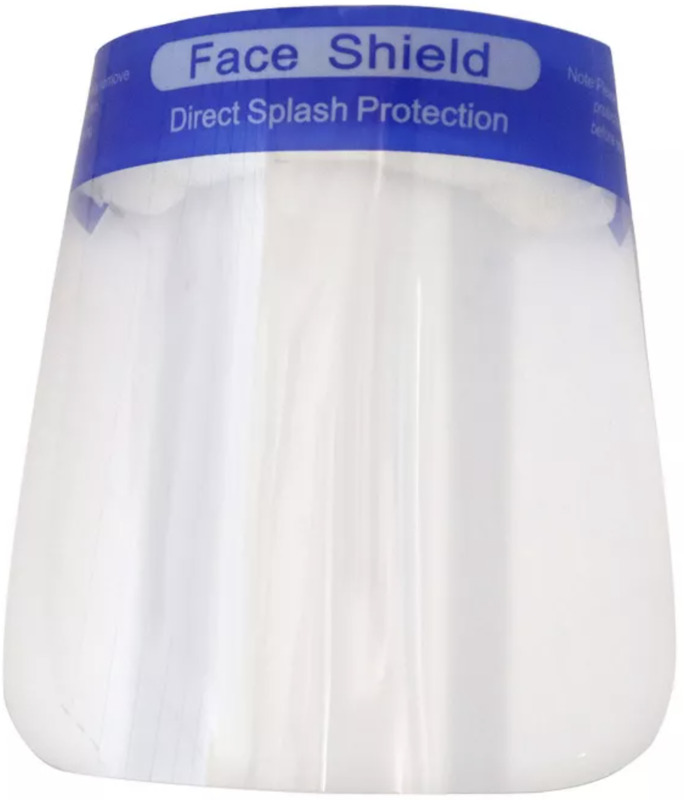 2020-04-17
2020-04-17A easier way to breath
This is a face shield that I used around family as an easier way to breathe without the mask on. -
 12/08/2020
12/08/2020Deshawn Lee Oral History, 2020/12/08
The novel coronavirus known as COVID-19, was first officially reported on December 31, 2019, by Chinese officials in Wuhan, China. Since then, the lives of people around the world have been dramatically transformed as the world’s population fights one of the deadliest and most contagious pandemics of modern history. Archivists of all different backgrounds quickly began engaging in what is known as rapid-response collecting—the archiving of historically important, donated artifacts and the collection of oral accounts from volunteer witnesses. Milwaukee resident Deshawn Lee was willing to sit down with Westley Hart, a student at UW-Eau Claire, and participate in the university’s effort, in collaboration with the Journal of the Plague Year Archive as well as the Chippewa Valley COVID-19 Archive Project, to engage in rapid-response collecting of oral histories from the Upper Midwest region. Deshawn comes in direct contact with the virus every day as he works, transporting patients from place to place at Froedtert Hospital and Medical College. He is also a hard-working student, pursuing a career in counseling while raising his 1-year-old daughter together with his girlfriend on the south side of Milwaukee. The purpose of this interview is to document the dynamic impacts that the coronavirus pandemic has had on Americans in the year 2020, particularly those of the Upper Midwest. His account touches on his personal interactions with the virus in work, school, and public, the actions that his local government has taken in response to the virus, as well as the virus’s interaction with the nationwide public protests that followed a series of high-profile police brutality tragedies, with an interest on the impact felt by his local Milwaukee community. -
 05/06/2021
05/06/2021Bekah Henn Orak History, 2021/05/06
C19OH -
2021-10-15
Tense and Tempestuous Tones
In the year 2020, I was a medical assistant working for a cancer surgery clinic. The pandemic posed huge challenges for people working in healthcare and created new staggering standards for cleanliness and infection control. With limited personal protective equipment and cleaning supplies, it made everyday clinic operations very challenging. With cancer patients, most of whom were undergoing treatments that lowered their immune system, and many of whom had just had surgery which can increase risk of infection, medical staff took COVID safety precautions very seriously. Dealing with people battling illness can be challenging under normal circumstances because they are often feeling emotional and scared, but during COVID, tensions were running even higher. I will never forget patients using condescending, edgy, and outright angry tones with me when I would call for a COVID symptom screening prior to their appointment, inform them that they had to wear a mask at all times while in the clinic, or that they were unable to bring a family member to the exam room during a follow-up appointment with a doctor. Over the phone and in person, many patients used tense and tempestuous tones to take out their anger over a situation none of us had any control over. Often, there were political connotations to any discussion of clinic COVID policy, which was unusual in a conversation about infection control. Many patients would protest getting their temperature taken or question the accuracy of their oximetry reading (a started part of vitals even before the pandemic). It was always a relief to have a patient who took a dignified breath and calmly understood that the rules were in place for everyone's safety and were an inconvenience to all involved. There were several days where I would go off to an empty exam room during my lunch break and cry. Tension during the first year of the COVID pandemic was audible. -
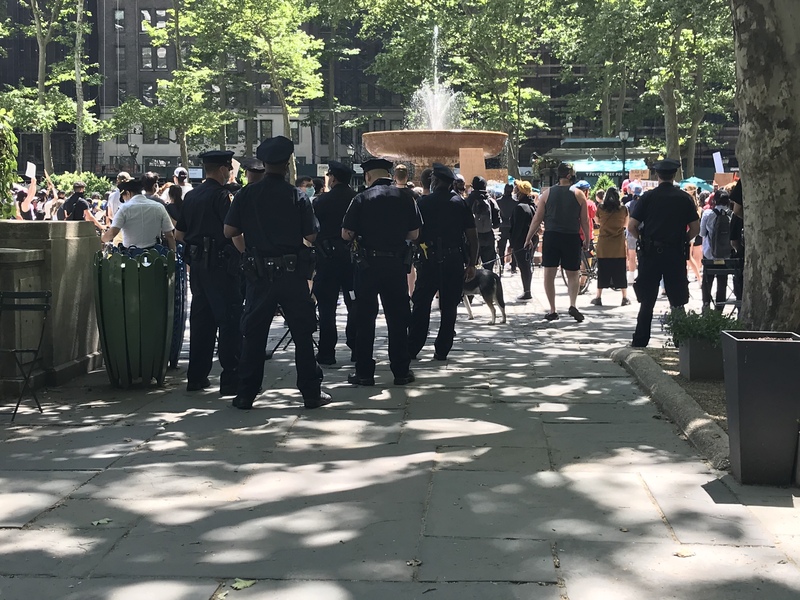 2020-05
2020-05Images from George Floyd Protests and BLM Demonstrations in New York City
Images taken of signs held while listening to speeches from BLM activists. Another image shows a cluster of police during a demonstration in Midtown Manhattan. -
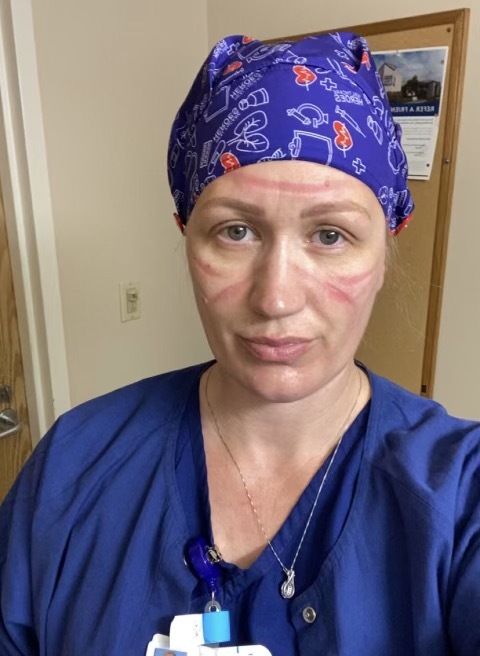 2020
2020Effects of PPE
This photo is an important reflection of what healthcare providers have had to endure and the lasting physical and mental toll the pandemic has taken. It was taken after a 12 hour shift of wearing PPE non-stop. -
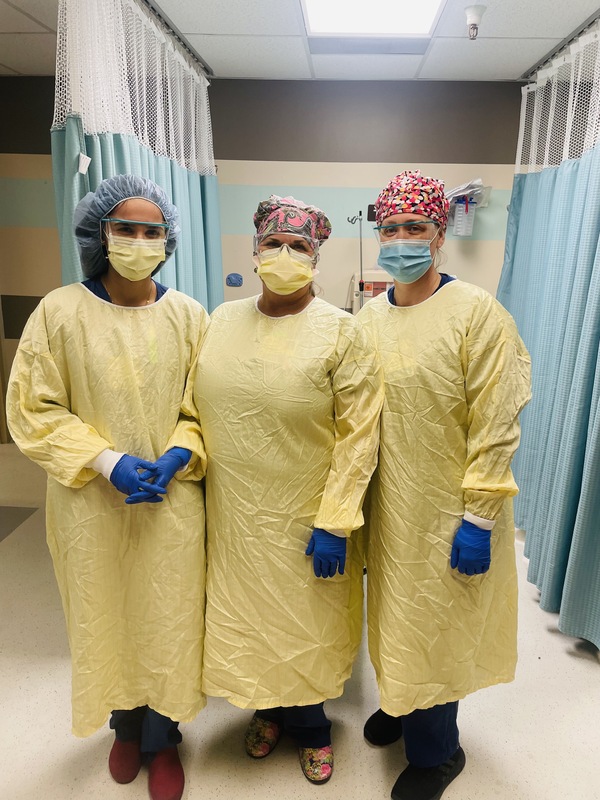 2021
2021Another Hospital
My mother worked at several hospitals throughout the beginning of the pandemic, as there were nurse shortages. At this particular location, she working in several units including the ICU, outpatient surgery, and distributing vaccines. This is important to me because seeing my mom dressed like this and hearing about how she worked in multiple places any given day put into perspective how dire the situation was and continues to be. -
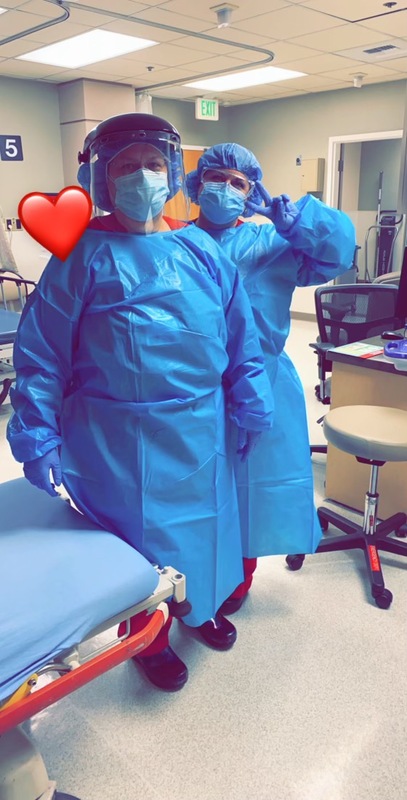 2020
2020My Mom Working in the COVID ICU
While this is not me, it is still important to me since it is my mom. She has worked in the COVID ICU almost the entire time, and I was really affected by seeing her gowned up like that the first time. Her career during my lifetime has not required so much PPE, so it was a really surreal moment that forced me to really appreciate the extremity of the pandemic and how much danger my mom was in. -
2021-10-06
COVID-19: The Impact of Power, Gender, Race, and Religion
Life during the COVID-19 pandemic is something that no one could have expected or prepared for. The way that our everyday lives instantly got disrupted and for many people their lives turned completely upside-down. We went from going to concerts, shows, and movies with friends and family, to lockdown in a brief second. Yet, for everyone lockdown, quarantine, and even work all looked different. There were many factors that went into trying to be able to stay safe and healthy during this time. Not everyone had the same advantages to try and protected themselves and their loved ones; some of the driving forces behind the advantages or disadvantage were power, gender, race, and religion. The more power, money, influence that you had during 2020 was what could almost guarantee that you and your family would be okay. By having money and power one was able to by as many masks as they wanted or by as much disinfectant as they could. Those people didn’t need to worry about if they could afford the inflated prices of hand sanitizers and Clorox wipes (if they could be found). Having power and money meant having information and accesses. This meant that those who possessed these things, could have accesses to doctors for healthcare purposes but also to get information about what was happening in their local area. With the possession of money also came space. Besides disinfectants and good masks such as N95s or KN95s, space was the next most luxurious thing people could have. Having space meant that you and your families weren’t all crowded on top of each other even if that’s how many people felt like they were because of lockdown. Having space also meant that if one of your loved ones got COVID-19, there was an area for them to quarantine and not but the rest of the people in the house at risk. Power and money were what separated those who could afford to stay at home and be safe and have minimal disruption to their lives, and those who still had to leave the house every day, if they were some of the fortunate ones to have jobs and put their lives at risk to try and provide for their loved ones. The way that gender was impacted by COVID-19, was that for lots of family’s stereotypical gender roles were reversed in some cases or even ceased for a bit. With everyone spending so much time at home, there was no more reason for any one person to be doing either the housework, looking after the children, or even doing all the cooking. While it is not just women that stay home with children, plenty of men to do, it is a stereotype that most women stay home with the kids and that the men work. Well with many people working from home or unfortunately being unemployed the jobs that typically might have fallen on mom became a mom and dad job. However, gender was not only impacted in these ways. While COVID-19 was already a hard, tough, and sad enough event domestic violence rose drastically during lockdown. Because people were forced to stay home, women especially since they are the dominant gender affected by domestic violence, had no option but to remain in the same environment as their abusers. This is not to say that men did not face the same situations but in America, 77% of domestic violence victims are female. Race played a huge part in the treatment of those with COVID-19 as well as accessibility to masks, disinfectants, and other forms of PPE. Areas all around the country that were not primarily made up of white people, were hit the harder with COVID-19. These groups of people were not given or provided the same level of care or protections that those where were white did, during this crisis. People who were any race other than white were treated as second class citizens to those who were white. They tended to be forgotten about by the healthcare system or were not prioritized the same way those who were white were. The color of your skin during 2020 could have been the difference between living or dying due to COVID-19. Religion was one of the biggest debates that surrounded the entire COIVD-19 pandemic. Religion was the cause for fights, violence, and even deaths of thousands of people. People used their belief in religion as a reason for why they did or did not believe in many parts of COIVD-19 crisis. One of the oldest debates in history is religion versus science, and this debate in modern times has never been so present in every part of the country and many parts of the world. Not only were people’s personal beliefs in religion playing a role in the chaos of the pandemic, but the attendance of religious gatherings such as church and temple causing issues as well. As a result of millions of people choosing to still attend religious gatherings, they were spreading the virus because of being in such close contact with many people. Even when there were executive orders in place prohibiting gatherings of over a certain size to prevent the spread of COVID-19, people still felt it was their right to go to these gatherings. The COIVD-19 pandemic impacted and altered the lives of billions of people. There are lots of factors that played a part of making the pandemic better and making the pandemic worse. However, at the end of the day the ones that were the most prominent were power, gender, race, and religion. -
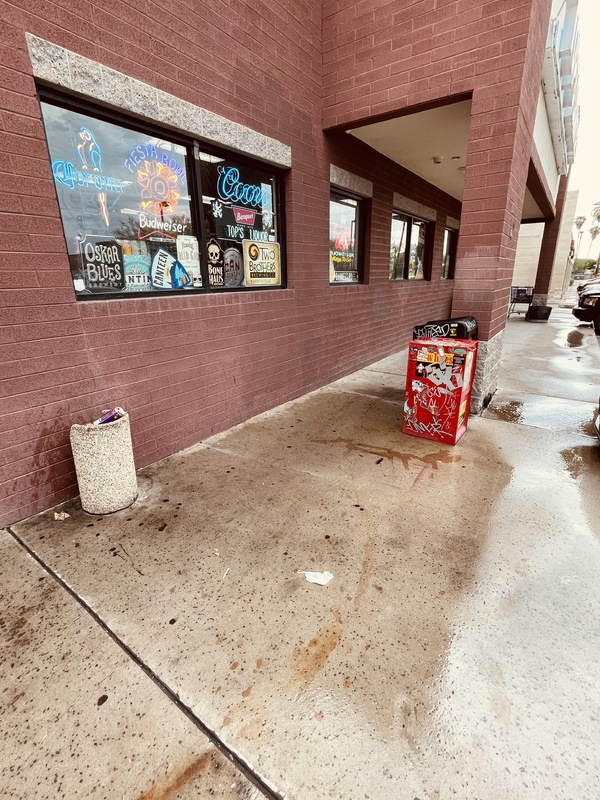 2021-09-18
2021-09-18Mask trash outside Tops Liquors
A white, disposable mask on the ground outside Tops Liquor. -
2020-03
Recollections from an Oncology Nurse
My mom is an oncology nurse and has worked in the field of nursing for the past 30 years. I recently asked her to talk to me about her experience this past year as a healthcare worker. She recalled the first week in March when things were becoming intense. People were asked to wear face shields and gowns as they were working in an immune-compromised area where the patients had cancer. At the time there was no vaccine. “It was incredibly intense and scary” my mother said. “People were worried about getting Covid from other staff at the hospital and also worried about contracting Covid from the patients.” “I walked into the hospital and there was an incredible underlying anxiety, the feeling of unease was palpable. People did not talk to each other like they normally did - everyone was consumed with the thought of not using each other’s pens, putting gloves on when receiving things from the pharmacy. Things we would never have even thought of before.” She continued, “It was a feeling of both being unsettled and a blind trust you put in your coworkers to be as clean, as responsible and in isolation outside of work as you. The intensity of that feeling was there the moment you walked in. The environment had changed. People were not as happy, communicative, relaxed.” She explained how working in Covid - there was an incredible newness to it - a fear and apprehension. -
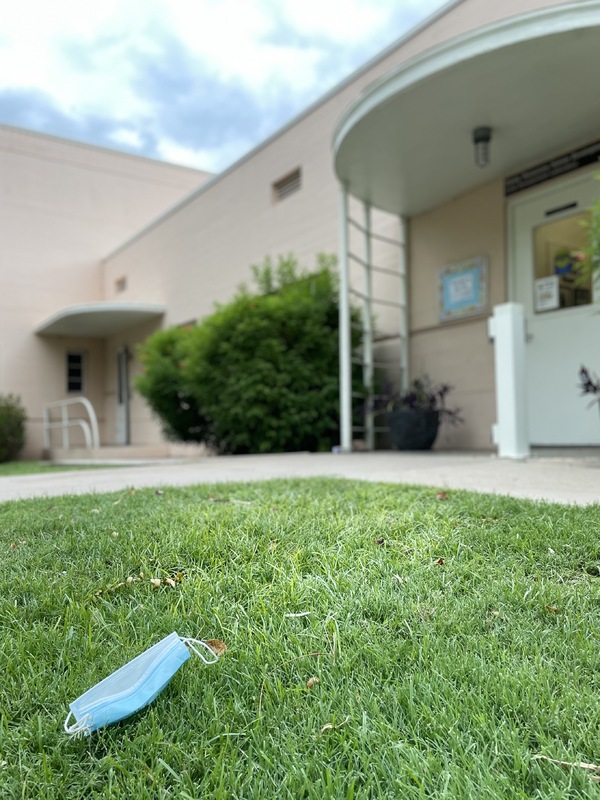 2021-08-21
2021-08-21Mask trash outside the CDL
Wednesday, August 18 was the eve of the first day of classes at Arizona State University. It was also the first week that the Child Development Lab (CDL) was open for daycare on campus. I picked my son up around 5:00 PM and took this picture of mask trash, likely unintentionally dropped by one of the parents outside the center. This image is part of the mask trash series. -
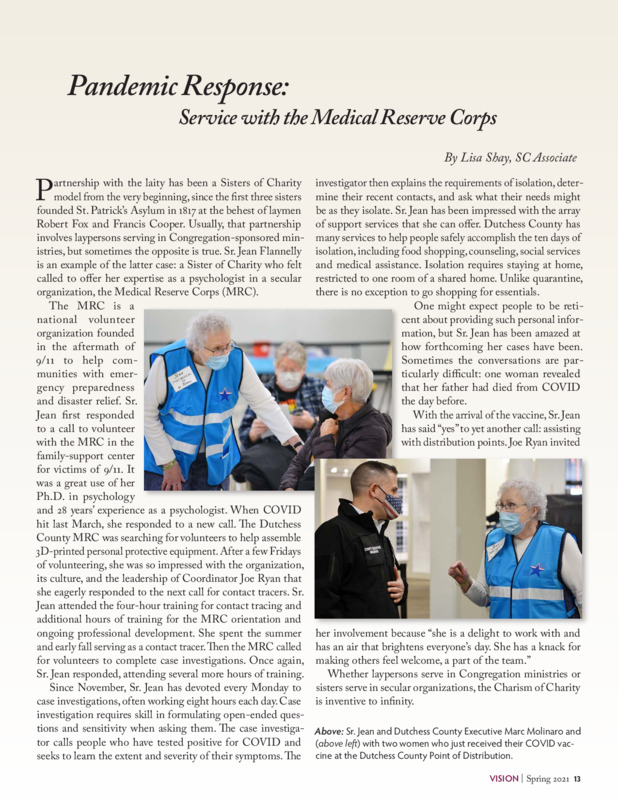 2021-03-02
2021-03-02A Religious Sister’s Service with the Medical Reserve Corps
This article celebrates the dedication of a friend and mentor, Sister Jean Flannelly, SC, who, at age 80, volunteered to serve with the Dutchess County New York Medical Reserve Corps to help people affected by the pandemic. Despite age and some health problems, she felt called to use her many talents as a psychologist, teacher, counselor and religious sister to do contact tracing, case investigation and serve in various roles at COVID-19 vaccination sites. She is an inspiration to me and to many! -
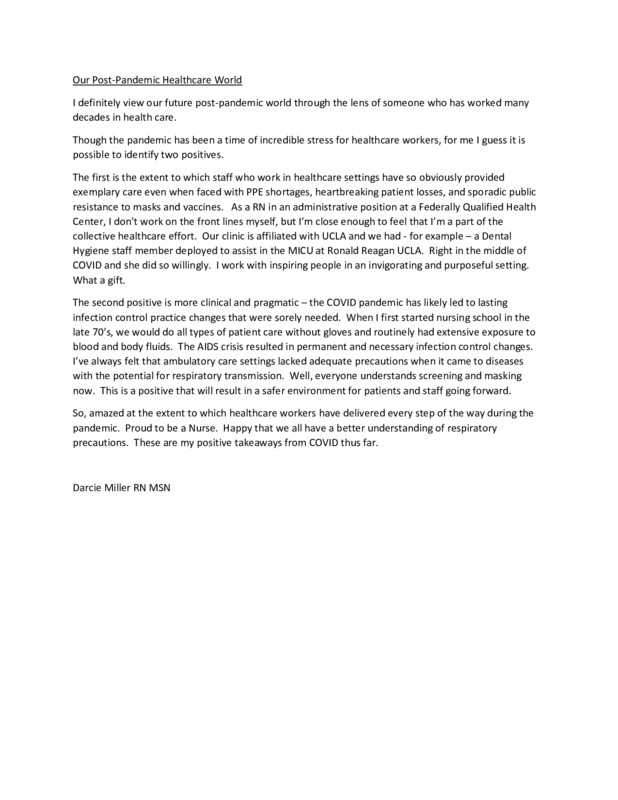 2021-08-13
2021-08-13Our Post-Pandemic Healthcare World
Our Post-Pandemic Healthcare World I definitely view our future post-pandemic world through the lens of someone who has worked many decades in health care. Though the pandemic has been a time of incredible stress for healthcare workers, for me I guess it is possible to identify two positives. The first is the extent to which staff who work in healthcare settings have so obviously provided exemplary care even when faced with PPE shortages, heartbreaking patient losses, and sporadic public resistance to masks and vaccines. As a RN in an administrative position at a Federally Qualified Health Center, I don’t work on the front lines myself, but I’m close enough to feel that I’m a part of the collective healthcare effort. Our clinic is affiliated with UCLA and we had - for example – a Dental Hygiene staff member deployed to assist in the MICU at Ronald Reagan UCLA. Right in the middle of COVID and she did so willingly. I work with inspiring people in an invigorating and purposeful setting. What a gift. The second positive is more clinical and pragmatic – the COVID pandemic has likely led to lasting infection control practice changes that were sorely needed. When I first started nursing school in the late 70’s, we would do all types of patient care without gloves and routinely had extensive exposure to blood and body fluids. The AIDS crisis resulted in permanent and necessary infection control changes. I’ve always felt that ambulatory care settings lacked adequate precautions when it came to diseases with the potential for respiratory transmission. Well, everyone understands screening and masking now. This is a positive that will result in a safer environment for patients and staff going forward. So, amazed at the extent to which healthcare workers have delivered every step of the way during the pandemic. Proud to be a Nurse. Happy that we all have a better understanding of respiratory precautions. These are my positive takeaways from COVID thus far. -
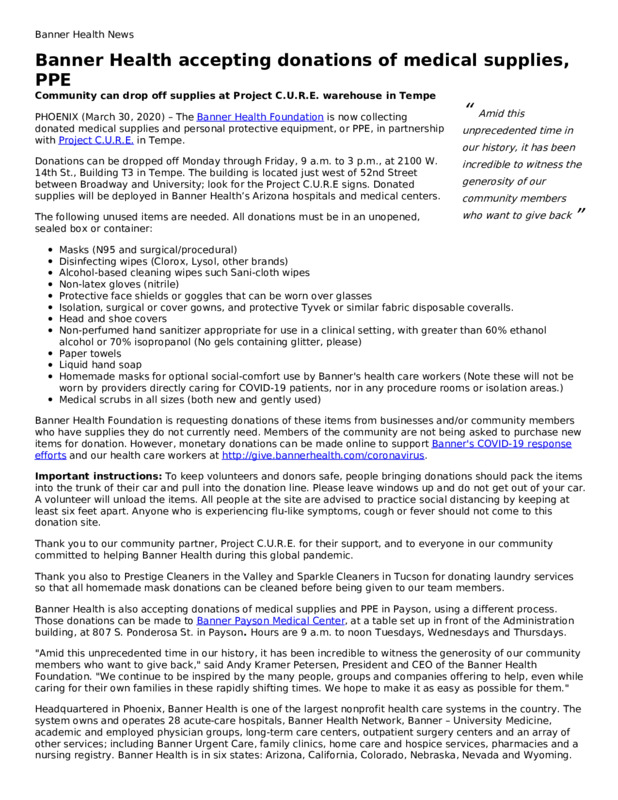 2020-03-30
2020-03-30Banner Health accepting donations of medical supplies, PPE
A press release announcing that The Banner Health Foundation is now collecting donated medical supplies and personal protective equipment, or PPE, in partnership with Project C.U.R.E. in Tempe. -
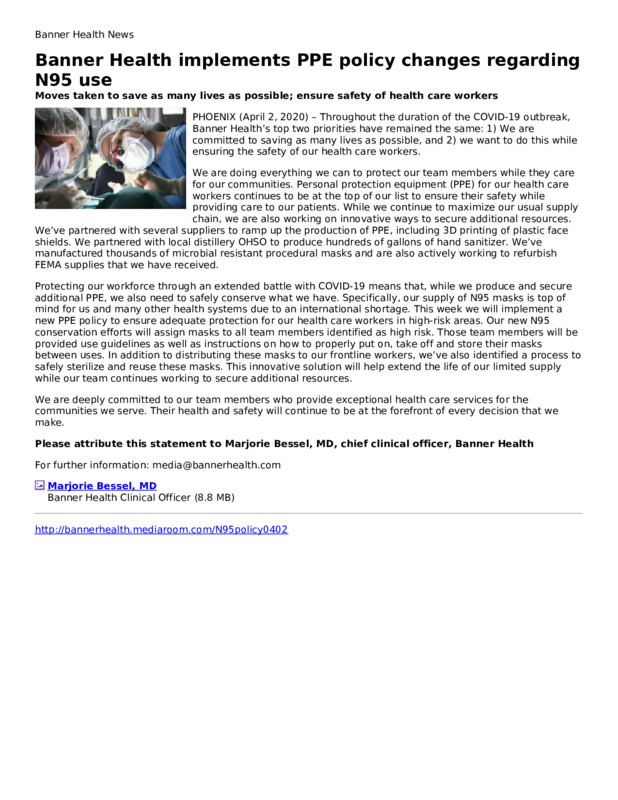 2020-04-02
2020-04-02Banner Health implements PPE policy changes regarding N95 use
A press release from Banner Health highlighting changes to policy; moves taken to save as many lives as possible; ensure safety of health care workers -
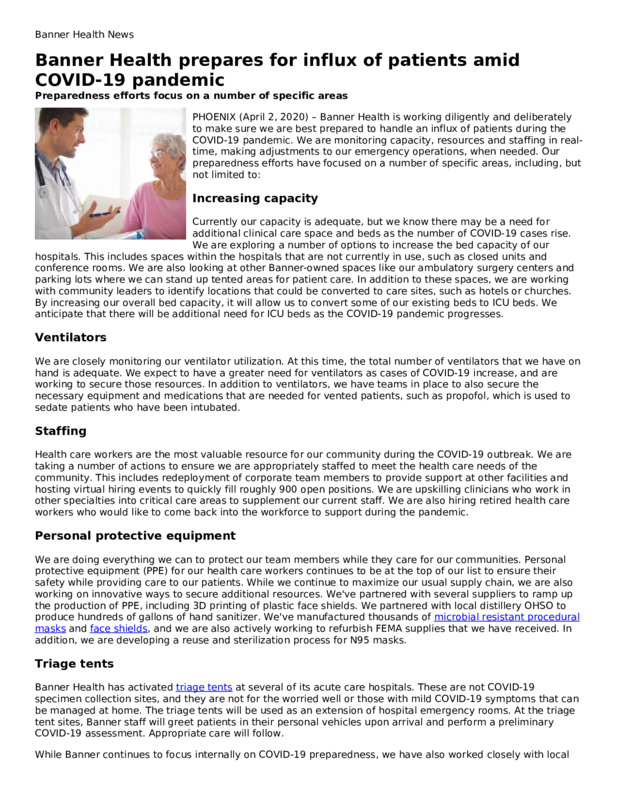 2020-04-02
2020-04-02Banner Health prepares for influx of patients amid COVID-19 pandemic
A press release from Banner Health announcing that they are "working diligently and deliberately to make sure we are best prepared to handle an influx of patients during the COVID-19 pandemic. We are monitoring capacity, resources and staffing in real-time, making adjustments to our emergency operations, when needed." -
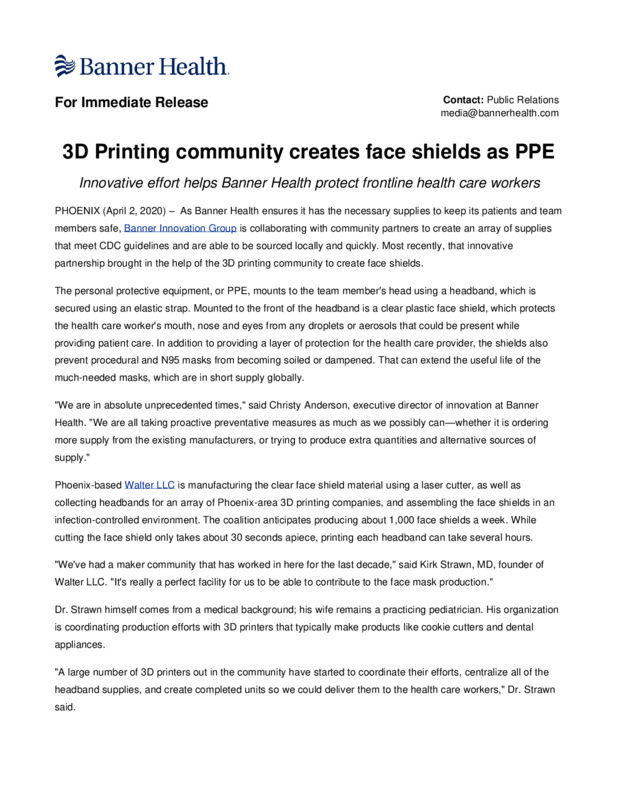 2020-04-02
2020-04-023D printing community creates face shields as PPE
As Banner Health ensures it has the necessary supplies to keep its patients and team members safe, Banner Innovation Group is collaborating with community partners to create an array of supplies that meet CDC guidelines and are able to be sourced locally and quickly. Most recently, that innovative partnership brought in the help of the 3D printing community to create face shields. -
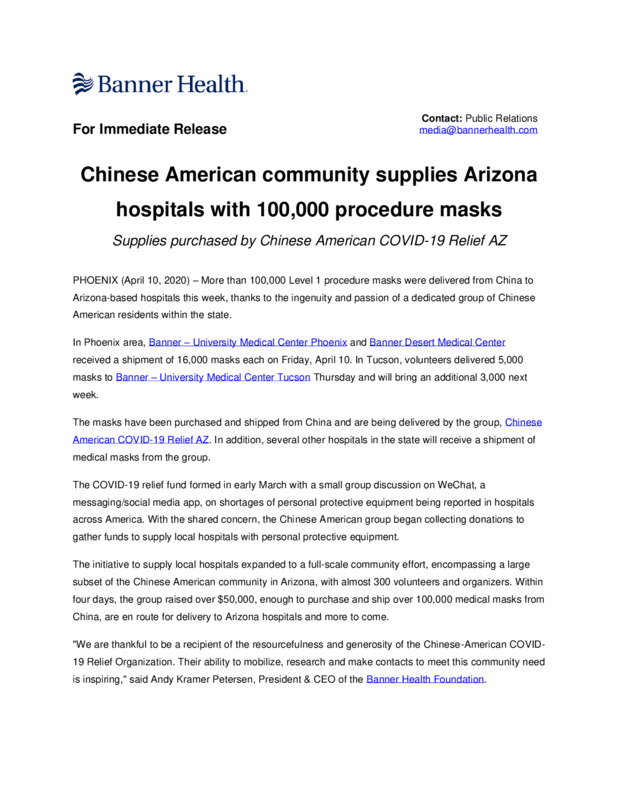 2020-04-10
2020-04-10Chinese American community supplies Arizona hospitals with 100,000 procedure masks
A press release from Banner Health announcing that more than 100,000 Level 1 procedure masks were delivered from China to Arizona-based hospitals this week, thanks to the ingenuity and passion of a dedicated group of Chinese American residents within the state. -
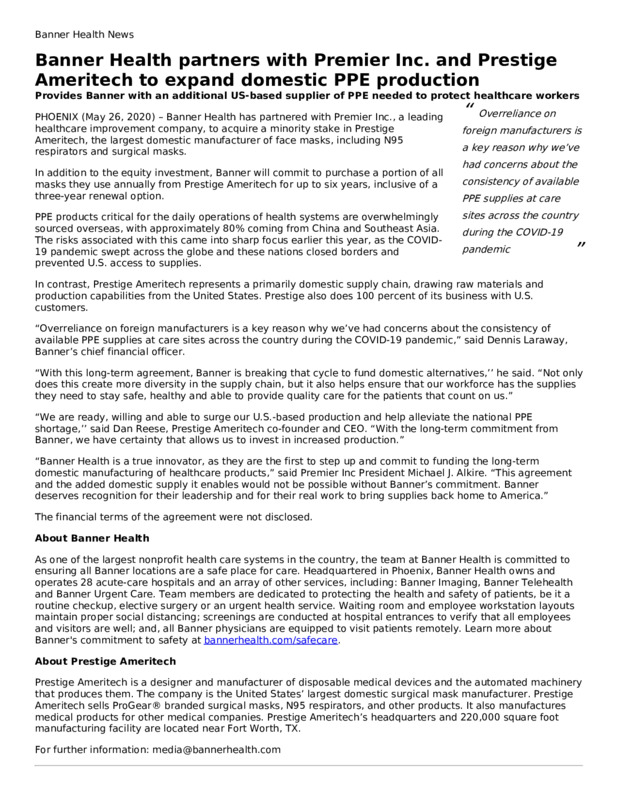 2020-05-26
2020-05-26Banner Health partners with Premier Inc. and Prestige Ameritech to expand domestic PPE production
A press release announcing that Banner Health partnered with Premier Inc., a leading healthcare improvement company, to acquire a minority stake in Prestige Ameritech, the largest domestic manufacturer of face masks, including N95 respirators and surgical masks. -
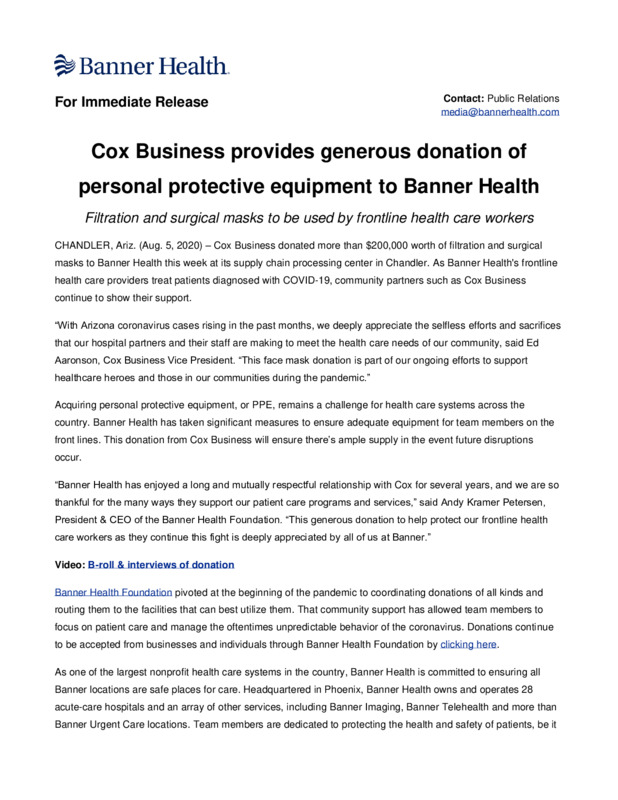 2020-08-05
2020-08-05Cox Business provides generous donation of personal protective equipment to Banner Health
A press release from Banner Health about Cox Business' donation of PPE and -
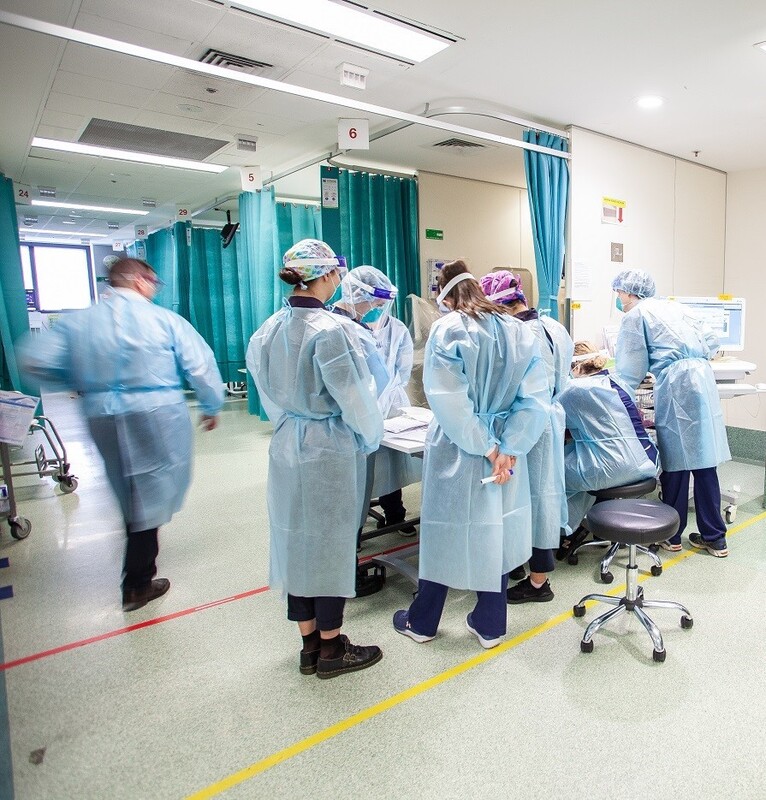 2020-08-11
2020-08-11Nurse handover Emergency Department, St Vincent's Hospital Melbourne
This photograph was taken in August 2020, the time when daily and active cases in Victoria's second wave were at their peak with hospitals adapting services and protocols in response. The photograph shows a nurse handover in the hospital's Emergency Department. The red line on the floor marks the boundary of the "hot zone" area dedicated to the care of patients regarded as infectious. Staff wear prescribed Level 4 PPE (Personal Protective Equipment) of gowns, face protection and N95 masks. -
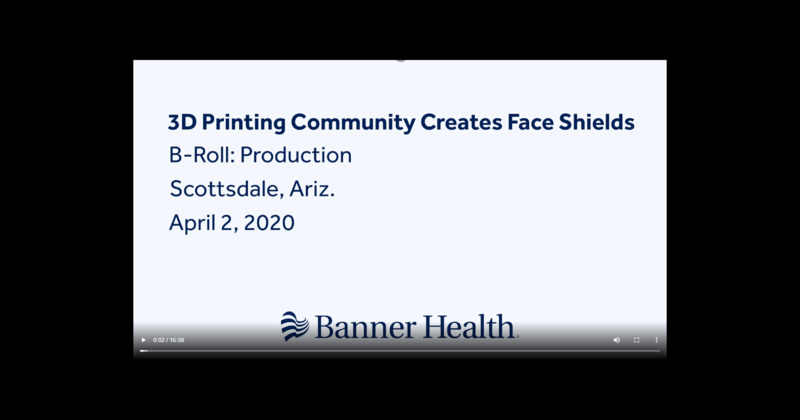 04/02/2020
04/02/20203D printed face shields
The 3D printing community is coming together to ensure Banner Health employees have the personal protective equipment (PPE) they need. Manufacturing is taking place across the Banner Health service area. -
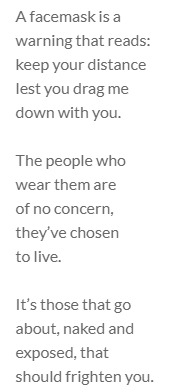 2021-06-23
2021-06-23Wedge issue
A facemask is a warning that reads: keep your distance lest you drag me down with you. The people who wear them are of no concern, they’ve chosen to live. It’s those that go about, naked and exposed, that should frighten you. -
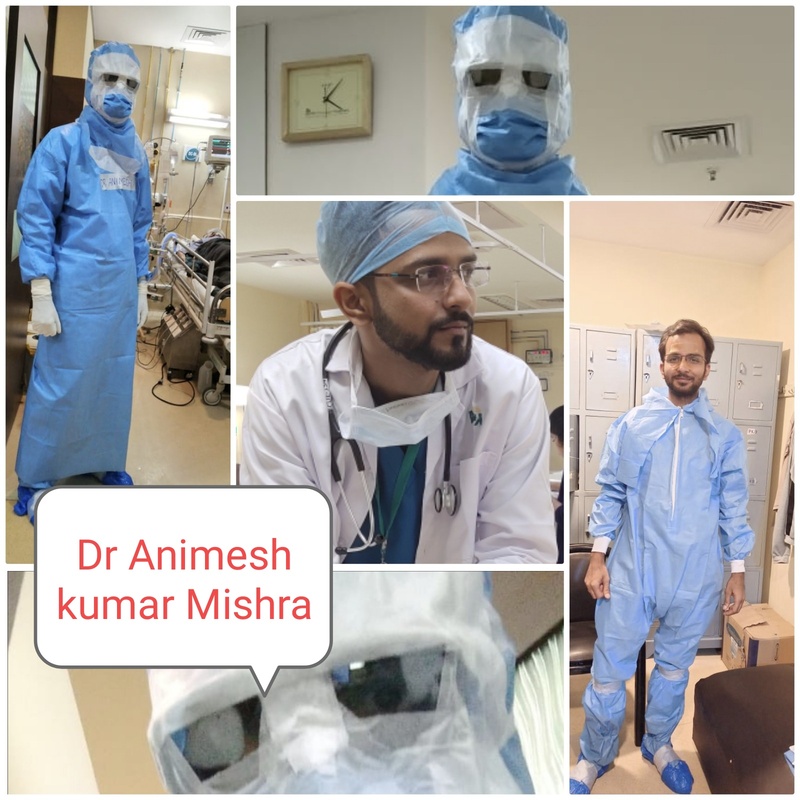 2021-05-07
2021-05-07Story of civic warrior 2 nd wave in india
Daily diary of a covid doctor for last 2 months…. The message towards the end of 2nd wave of pandemic The last 2 months of 2nd wave of the pandemic have been the most hectic in all aspects emotionally, physically, personally. Finally got some time to pen down my experience towards the end of this 2 wave. Working in territory care hospital as an intensivist, managing own start-up Providing doctors on call for a home visit, tele and video consultation, free consultation for underprivileged people. Every day waking up after hardly 2 to 3 hours of sleep. I will would see 10 to 15 miss calls, Finish teleconsultation as much as possible and then do a home visit for few patients on the way to hospital, Home visit for covid patients has been a totally different experience, these were the patients under the most stressed condition not getting hospital beds, their family physician had stopped seeing them due to fear of self infection. with proper PPE protection treating patients at home successfully is so self satisfactory as a doctor which only COVID warriors like us can understand. Then reaching my COVID ICU where the sickest patients in the city are there, managing such a sharp surge in critical cases has been a Herculean task, time is key in critical care setup, the timely decision to give ventilator support or ECMO support saved few lives. thankfully I have the best doctors, nurses, paramedics, housekeeping, and management guys who make our work easy. Those grueling 8 hours In PPE without food water or toilet. And the most important was talking with the family of those sick patients, ask any 1 of our covid warriors every1 has hundreds of sad story of each family. This used to break us emotionally. Coming out of covid ICU, the number of missed calls for teleconsultation was pending. I would finish them while having lunch In the evening. During the peak of this my wife working as anesthesia Doctor at BHU got infected for 2 nd time, And lost 2 elder family member due to COVID, But the patient's family expectations from me kept me doing my work, and didn't visit my sick wife or attended the funeral of any of my relatives. Then in late-night had kept free teleconsultation slot for my native hometown Sindri, Dhanbad patients. And also underprivileged patients from pan India. After finishing calls, night again would start home visit for covid patients which would go till 2 to 3 am in the morning. Then finally to find a nap of few hours till the next day of battle. This is the story of lakhs of lakhs of covid warriors like me. But think about us now we are also getting burnt out, So request all people not to relax after 2 nd wave, get vaccinated use mask maintain social distancing even after govt unlocks, it's not over yet………... Dr Animesh Kumar Mishra Critical care medicine specialist Apollo Gleneagles Hospital. Founder of DCHS healthcare solutions. 9176138128 -
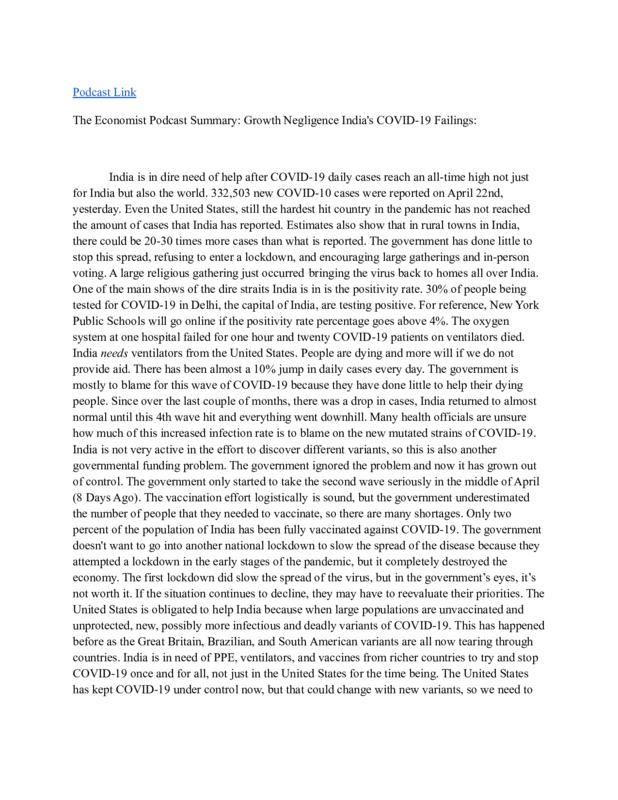 2021-05-01
2021-05-01INDIA DYING
This is a breakdown of facts and my opinions on the India Coronavirus situation. -
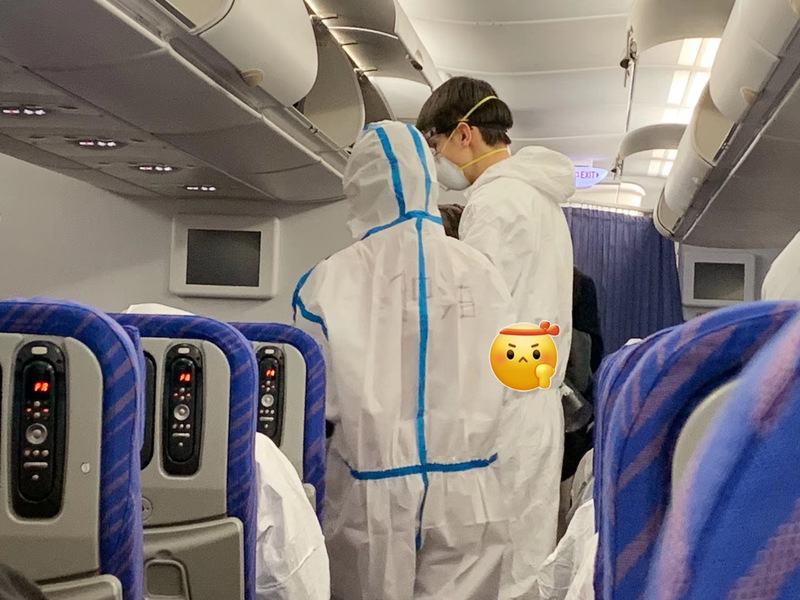 2020-03-26
2020-03-26A Long Way Home
As an international student from China, one of my most impressive experiences about COVID-19 was the long journey when my friends and I returned home from Denver to Beijing. We knew this journey home is bound to be challenging since it happened at such a particular time. The first challenge we faced is to make preparation for the flight. Getting on a flight successfully is largely a matter of luck, as you never know if your flight will be canceled just before the departure date. Due to changing flight policies, our tickets were canceled three times. At that time, my friends and I felt deep powerlessness in the unstable situation. Fortunately, after the fourth flight adjustment, we successfully boarded the journey home. To prevent being infected by coronavirus at the crowded airport, we armed ourselves to the teeth. We wore medical gloves and masks, raincoats (because protective suits were sold out), and we even prepared ski goggles since the safety goggles were sold out too. During the 18 hours on the plane, we just ate a few bars of chocolate and drank some water. And that was the second challenge we faced. However, thanks to the company and encouragement of my two friends that made our time on the plane less stressful and depressed. When we arrived wearily in Guangzhou, we found out a new policy just published that requires returnees to be quarantined as soon as they got off the plane. Therefore, we had to cancel the ticket from Guangzhou to Beijing. As soon as we got off the plane we were taken to a local hotel where we are going to be quarantined for 14 days. During the quarantine, I went through an experience I never had before. Food is delivered to us every day by staff wearing protective suits. And we measured our body temperature at regular intervals every day. In order to overcome the loneliness during the 14 days, my friends and I created an online meeting room, which made us feel that we are eating and studying together. Finally, 16 days after leaving Denver, my friends and I returned to our hometown Beijing. For me, there is nothing happier than seeing my parents in person and eating food cooked by them! My friends and I grew up a lot after going through this experience. This long way home taught us the importance of adjusting mood and supporting each other in times of crisis. -
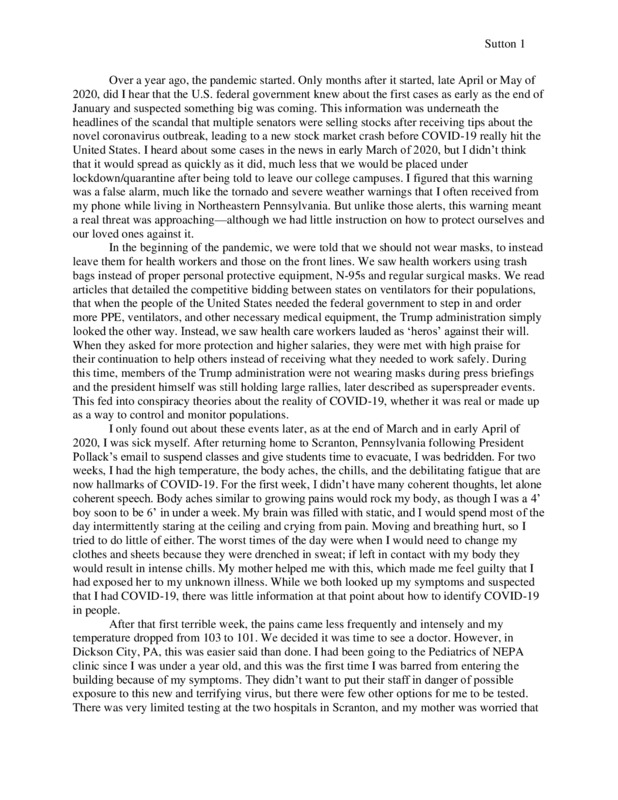 2021-05-18
2021-05-18On Illness From a Virus and Surgery During the COVID-19 Pandemic
In this essay, I reflect on my personal experiences with illness and recovering from surgery during the COVID-19 pandemic. -
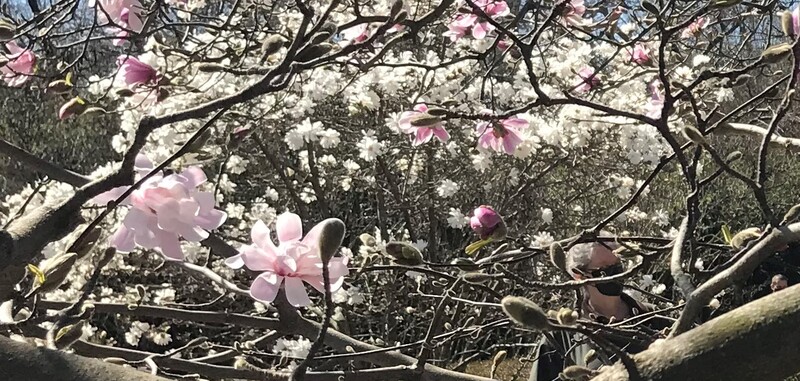 2021-04
2021-04Masked Faces Through Foliage
Ever since the pandemic started, I’ve been spending a lot of time outdoors in parks and public gardens. While outdoors, I often take photographs. Recently I was looking through my photos and noticed that many of the ones taken in March and April 2021 showed masked faces through foliage. Somehow this seemed like a good way to remember Spring 2021. -
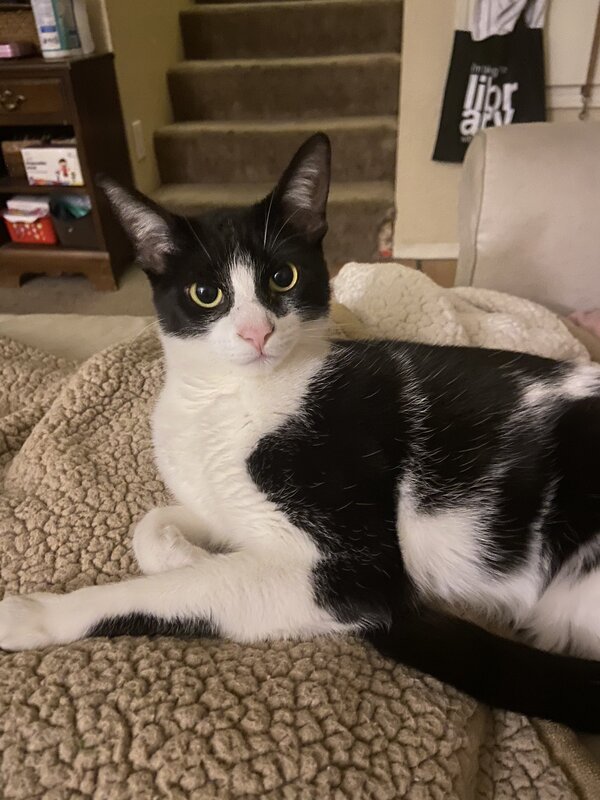 2021
2021Covid-19 in the background of life
I have a lot of photos taken in this spot. Our animals and children are cute and tend to hang out on the sofa. I was scrolling back through my online albums and noticed something the background of my photos from the last year all have in common. The tote bag hanging off the closet door is for used masks as we come in. The little table across the stairs is our home PPE station. It wasn’t there a year ago. The baskets are filled with cloth masks of various sizes and styles (it took a lot of trial and error to find masks that fit both kids) and the drawer has a touchless thermometer, among other things. The top has wipes, hand sanitizer, and a UV phone sanitizer that was on back order for months before it arrived. We will always be able to identify the year these photos were taken thanks to a collection of stuff I couldn’t imagine having eighteen months ago. I wonder how long it will stay? -
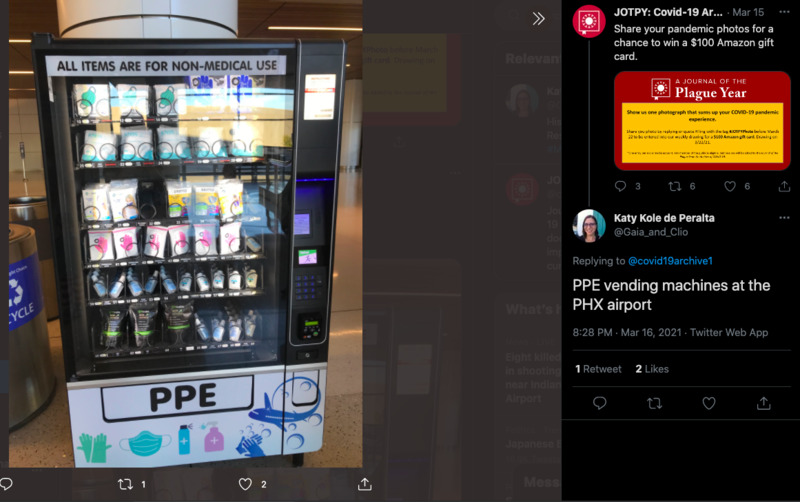 2021-03-16
2021-03-16#JOTPYPhoto from Katy Kole de Peralta
PPE vending machines at the PHX airport -
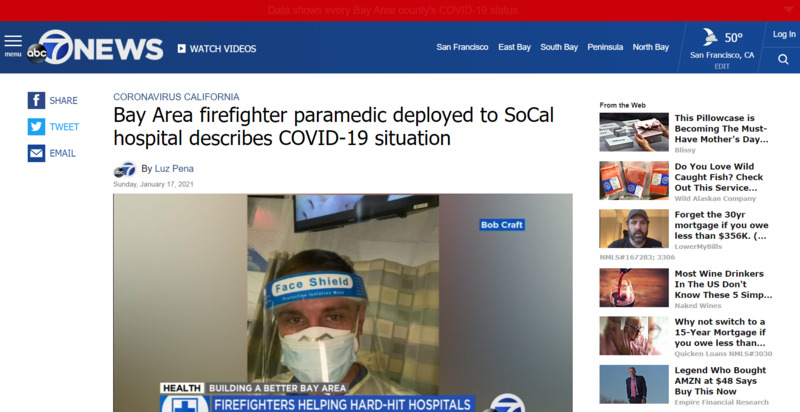 2021-01-17
2021-01-17Bay Area firefighter paramedic deployed to SoCal hospital describes COVID-19 situation
MARIN, Calif. (KGO) -- As COVID-19 cases surge, Bay Area firefighters are getting deployed to hospitals across the state. Bob Craft, a firefighter paramedic from the Central Marin Fire Department is working the nightshift. Two hours into his shift, he intubated a patient in the emergency department who arrived to the hospital with stroke like symptoms and prepped a COVID-19 patient for their flip onto their stomach for the rest of the night. "It's the gamut from really regular people coming to the emergency department to people on ventilators on the ICU who are on the COVID ward," said craft. -
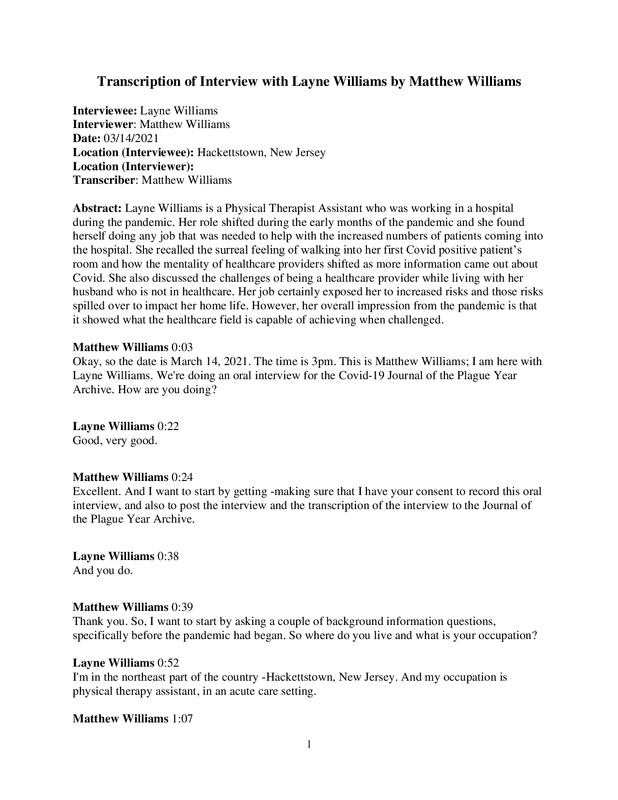 03/14/2021
03/14/2021Layne Williams Oral History, 2021/03/14
Layne Williams is a Physical Therapist Assistant who was working in a hospital during the pandemic. Her role shifted during the early months of the pandemic and she found herself doing any job that was needed to help with the increased numbers of patients coming into the hospital. She recalled the surreal feeling of walking into her first Covid positive patient’s room and how the mentality of healthcare providers shifted as more information came out about Covid. She also discussed the challenges of being a healthcare provider while living with her husband who is not in healthcare. Her job certainly exposed her to increased risks and those risks spilled over to impact her home life. However, her overall impression from the pandemic is that it showed what the healthcare field is capable of achieving when challenged. -
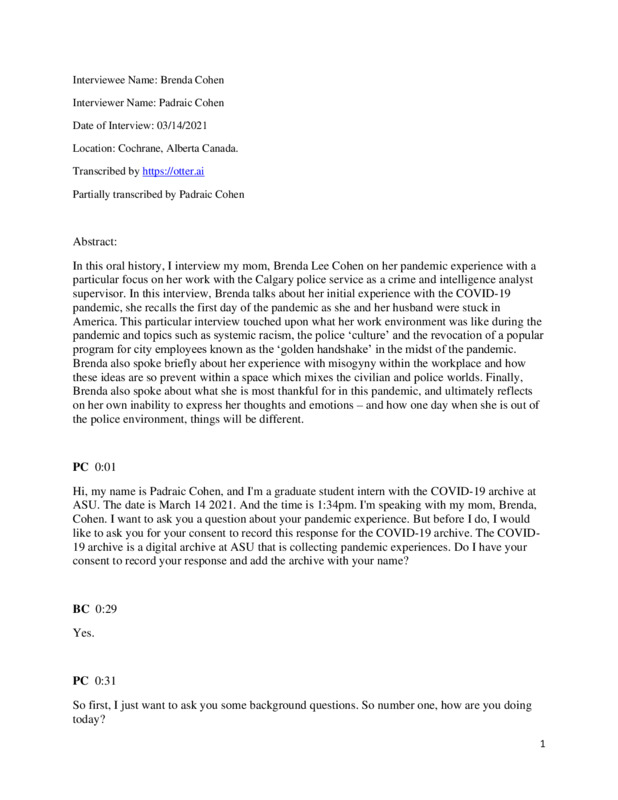 2021-03-14
2021-03-14Brenda Cohen Oral History, 2021/03/14
In this oral history, I interview my mom, Brenda Lee Cohen on her pandemic experience with a particular focus on her work with the Calgary police service as a crime and intelligence analyst supervisor. In this interview, Brenda talks about her initial experience with the COVID-19 pandemic, she recalls the first day of the pandemic as she and her husband were stuck in America. This particular interview touched upon what her work environment was like during the pandemic and topics such as systemic racism, the police ‘culture’ and the revocation of a popular program for city employees known as the ‘golden handshake’ in the midst of the pandemic. Brenda also spoke briefly about her experience with misogyny within the workplace and how these ideas are so prevent within a space which mixes the civilian and police worlds. Finally, Brenda also spoke about what she is most thankful for in this pandemic, and ultimately reflects on her own inability to express her thoughts and emotions – and how one day when she is out of the police environment, things will be different. Interviewee Name: Brenda Cohen Interviewer Name: Padraic Cohen Date of Interview: 03/14/2021 Location: Cochrane, Alberta Canada. Transcribed by https://otter.ai Partially transcribed by Padraic Cohen -
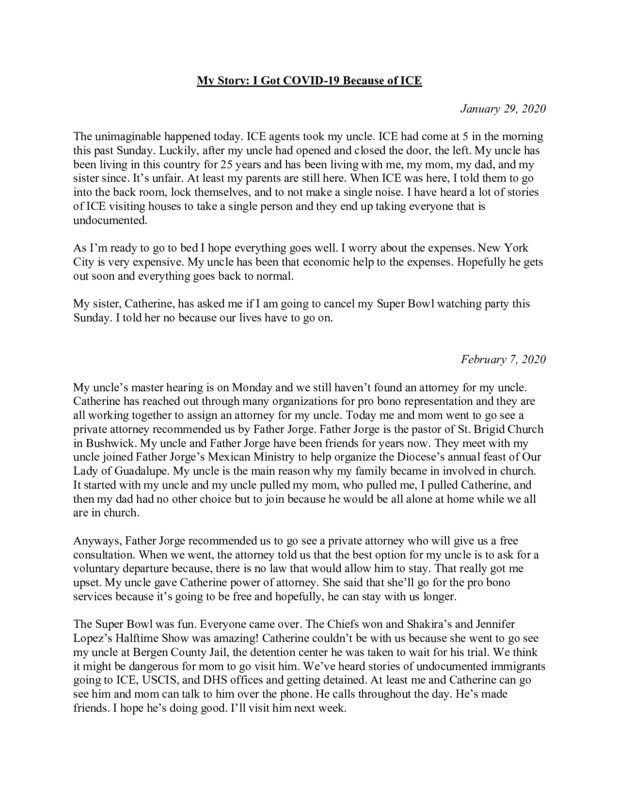 2021-02-14
2021-02-14My Story: I Got COVID-19 Because of ICE
I am sending a diary style writing where I share my experience during the pandemic. I focus on the issue of ICE during the pandemic. Before the lockdowns, my uncle was detained by ICE and was deported during the pandemic. My uncle has been living in the US for 25+ years and Mexico, my uncle's home country, has changed a lot since he last lived there. For that reason, I went to Mexico to take him home. This made me get COVID. -
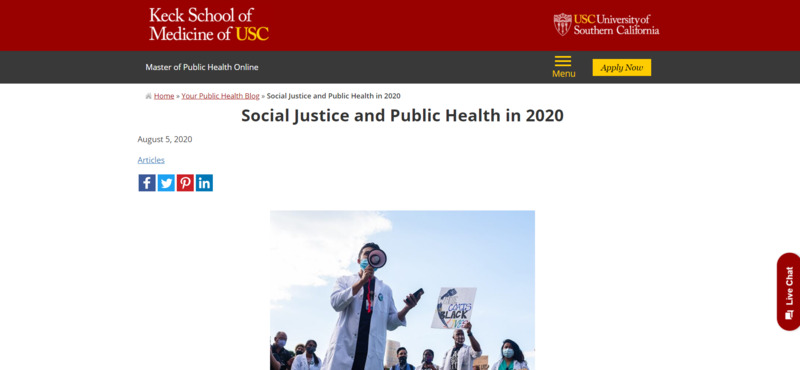 2020-08-05
2020-08-05Social Justice and Public Health in 2020
From the article: The COVID-19 pandemic, caused by the spread of the novel coronavirus, has created an unexpected and unprecedented lifestyle shift for many people across the globe. Several months into the pandemic, the public has been exposed to a number of issues they might not have previously considered or thought possible, from hospitals rapidly reaching capacity and the lack of personal protective equipment (PPE) to the mental and social challenges of physical distancing and being quarantined. -
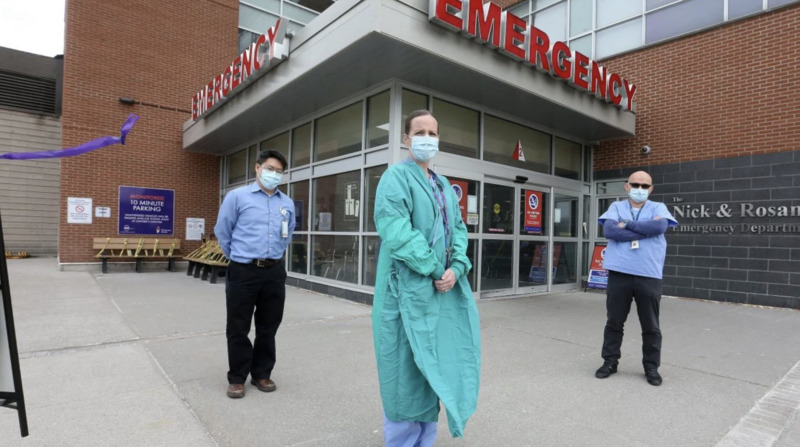 2021-02-08
2021-02-08Recognize Their Courage and Sacrifices
Evaluating the financial impact of the pandemic on the country, House representatives are asking the government to remember and acknowledge those working on the frontlines and their families. The Bloc Québécois demands the government "significantly and sustainably increase Canada health transfers before the end of 2020." -
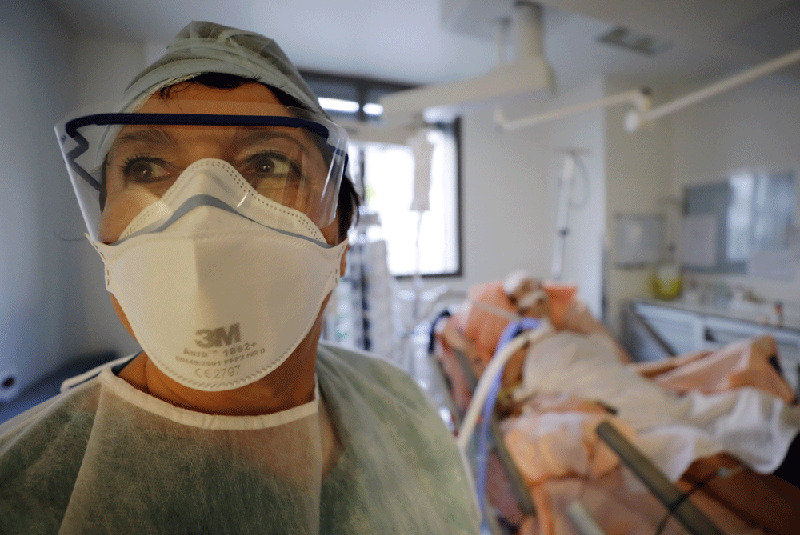 2021-02-02
2021-02-02Inadequate Sick Leave Jeopardizes Canadian Health Workers and Patients
Due to inadequate medical supplies, lack of vaccines, and inability to slow down the spread of the virus, the pandemic rages on. To make matters worse, over half of Canadian workers lack sufficient sick leaves, which contribute to more outbreaks and the dangers of contracting COVID-19.
